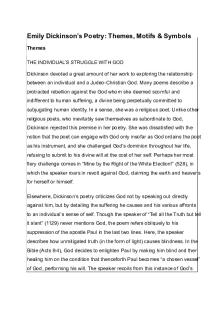Dickinson Analysis I heard a Fly buzz PDF

| Title | Dickinson Analysis I heard a Fly buzz |
|---|---|
| Course | Poésie |
| Institution | Université Gustave-Eiffel |
| Pages | 4 |
| File Size | 73.6 KB |
| File Type | |
| Total Downloads | 58 |
| Total Views | 136 |
Summary
Download Dickinson Analysis I heard a Fly buzz PDF
Description
I heard a Fly buzz - when I died – (591) BY EMILY DICKINSON I heard a Fly buzz - when I died The Stillness in the Room Was like the Stillness in the Air Between the Heaves of Storm The Eyes around - had wrung them dry And Breaths were gathering firm For that last Onset - when the King Be witnessed - in the Room I willed my Keepsakes - Signed away What portion of me be Assignable - and then it was There interposed a Fly With Blue - uncertain - stumbling Buzz Between the light - and me And then the Windows failed - and then I could not see to see -
The rythme = Iambic rythme, alternation of tetrameters (4 stresses) and trimeters (3 stresses) Onset = start of something / the beginning Interposed= caracteristic of her style
1st santza:
The dashes influence the rhythm of the poem. It interupted it. I heard a Fly buzz – when I died The buzz is caracterize has uncertain and stumbling (in the poem there are sounds effects.) The fly comes to disturb the solemn rythme of the poem. Fly, Stillness Room, Stillness Air, Heaves Storm => Stillness repetition => atmosphere in the room, sound effect, echoing effects. Alliteration in the s sound => could be associated with the fly. First stanza is describing the atmosphere of the room. Its a poem about the fly but she appeared at the beginning and at the end. Its a circle poem. The poem is about breath and breathing Run-on line or enjambment The beat of the heart Irregularity of the rhythm – buzzing of the fly I heard = its a poem about the sence of earing contrast btw the buzzing and silence – discontinuity of the buzzing + discontinuity the dashes The fly is the desturbing element of the poem – the fly is here to eleveate the solemnity of the poem. Fly = death of the body. Decay in body. The fly announces death coming. 3 and 4 lines are a chiasme and a comparison association btw two stillness and also btw stillness and “heaves of storm” association btw the room and the air air = fly, breathing, buzzing, musics methapore of storm
2e stanza: this stanza referes to the buzzing of the fly, the heaves of storm could be the coming of death = mourners Eyes and Breaths = synechdoque, the part for the whole, metonymy “had wrung them dry” stoping crying gather your breath = gathering of the sobbing The speaker is dying “king” metonymy for God. The moment of death. Paradoxical Oxymoron: Death is not onset, beginning of life. = Methaphisical argument. The last assault of death Fly = Belzebuth. Figure of the devil 3rd stanza: 1st person speaker is present Keepsakes (souvenirs) The king = God ; the fly = Devil => they are never in the same stanza accepting that she's dying, last transition btw the mourners and her. portion: comparision btw part of her body, to keep souvenirs Belongings, presence of signs: refering to a will, what to give away when you die + discontinuity in general. 4th stanza: part devoted to the fly the style is simple and pure
its like telling a story, color= blue (fly) Blue Buzz – mixes census – synesthesia (impossible) the light stands for death of the after life, the moment of passing, death, and the fly interposes btw the “light” and “me”. So the fly is always a disturbing elmt. Windows = eyes. Eyes = soul. “failed”? Eyes closed. Open ending At the end “I could not see to see -” = modernity = modern writing Fly = methaphor for Dickinson's writing – mise en abîme. Gothic elements in this poem...
Similar Free PDFs

If I could fly - essay
- 2 Pages

Seen and Heard Training
- 3 Pages

Emily Dickinson - notes
- 6 Pages

Fly A - Step 4 -Quiz 1
- 5 Pages

Buzz words for exams
- 5 Pages

1 LAPORAN PRAKTIKUM Fly Grill
- 1 Pages

Fruit Fly Genetics final
- 2 Pages

Cardio - buzz words for exams
- 5 Pages

Final Fruit FLY LAB
- 10 Pages

Alaska Fly-Fishing Expedition
- 3 Pages

Fly, ludovico einaudi
- 8 Pages
Popular Institutions
- Tinajero National High School - Annex
- Politeknik Caltex Riau
- Yokohama City University
- SGT University
- University of Al-Qadisiyah
- Divine Word College of Vigan
- Techniek College Rotterdam
- Universidade de Santiago
- Universiti Teknologi MARA Cawangan Johor Kampus Pasir Gudang
- Poltekkes Kemenkes Yogyakarta
- Baguio City National High School
- Colegio san marcos
- preparatoria uno
- Centro de Bachillerato Tecnológico Industrial y de Servicios No. 107
- Dalian Maritime University
- Quang Trung Secondary School
- Colegio Tecnológico en Informática
- Corporación Regional de Educación Superior
- Grupo CEDVA
- Dar Al Uloom University
- Centro de Estudios Preuniversitarios de la Universidad Nacional de Ingeniería
- 上智大学
- Aakash International School, Nuna Majara
- San Felipe Neri Catholic School
- Kang Chiao International School - New Taipei City
- Misamis Occidental National High School
- Institución Educativa Escuela Normal Juan Ladrilleros
- Kolehiyo ng Pantukan
- Batanes State College
- Instituto Continental
- Sekolah Menengah Kejuruan Kesehatan Kaltara (Tarakan)
- Colegio de La Inmaculada Concepcion - Cebu




